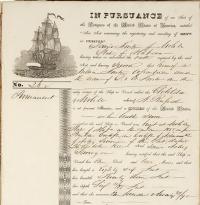
Insurance document for slave schooner Clotilda
At the end of January, we posted about a shipwreck that was suspected to be the remains of the schooner Clotilda, the last vessel to carry slaves to the United States. The wreck was roughly in the right place on Mobile River just off Twelvemile Island. From what could be seen from above the river mud, the vessel was about the right size, and at one point appeared to have been burned, as was the Clotilda before she was abandoned. Now however after further research and excavation, the Alabama Historical Commission has issued a report concluding that the newly discovered wreck is not that of the infamous slave schooner.
The commission report concluded that the wreck was that of a ship which was too large, built of the wrong species of wood, with the wrong rig, and probably newer than the Clotilda.
The wreckage was exposed following a winter “bomb cyclone” weather front, which caused extremely low tides in the area, exposing the wreckage. Without a permit, the researchers who found the exposed wreckage could only survey the exposed section of the ship extending above the river mud. Experts from the Alabama Historical Commission (AHC), in coordination with the National Park Service (NPS), the Smithsonian National Museum of African American History and Culture, (NMAAHC), and SEARCH, Inc, subsequently were able to literally dig deeper into the wreck. Their findings ruled out the wreck which they refer to as the ” Twelvemile Island Wreck” being the Clotilda based on the following findings:
- Clotilda was 86 feet long while the length of the Twelvemile Island Wreck is 158 feet, 5 inches. The interior “depth” inside Clotilda was 6 feet, 11 inches while the interior depth of the Twelvemile Island Wreck is too deeply buried in the mud to measure completely but is at least 10 feet deep based on the amount of the bow structure remaining onsite.
- The size of timbers on the wreck is larger than those that were used to build a vessel the size of Clotilda. For example, the frames, or “ribs,” are 10 by 10 inches and the hull planks are 2 inches thick. Clotilda would have frames 2 inches smaller and planks ½ inch thinner.
- Clotilda had 2 masts. The size of the Twelvemile Island Wreck is too large for a 2 masted rig, which originally had 3 masts.
- The Twelvemile Island Wreck has flat iron reinforcing the hull, which is commonly found on larger wooden vessels built from the 1850s through the early 1920s. This timeframe is after the construction of Clotilda.
- While the wood samples have not yet been analyzed, all of the wood observed on the Twelvemile Island Wreck appears to be softwood such as pine. Clotilda was built with oak and yellow pine. There was no oak observed on the Twelvemile Island Wreck.
- A large portion of the upper bow of the Twelvemile Island Wreck is buried in mud on the shoreline. The condition of the wood indicates this wreck was largely an intact vessel that was abandoned on the shore. It slowly deteriorated with marine organisms eating the wood above the mud until heavier parts of the hull collapsed.
- Clotilda was burned and then sank. There is no definitive evidence of burning on the Twelvemile Island Wreck. The damage from small marine organisms that eat wood can look similar to fire damage.
Thanks to Irwin Bryan and Phil Leon for contributing to this post.

Fair enough… but where is the real Clotilda? 🙂